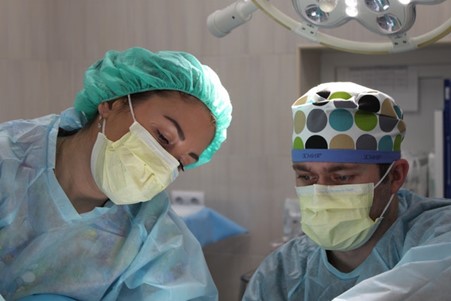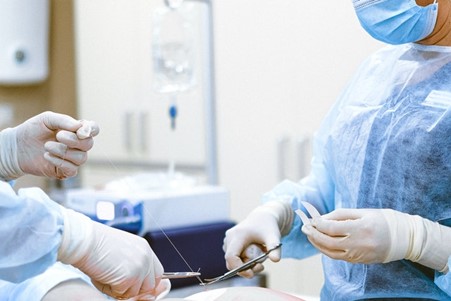Surgeons are often viewed as an elite tier of doctors renowned for their steady hands, surly dispositions, and eyes for detail. Unlike other fields of medicine, though, surgeons cannot practice their craft by passively studying books or speaking with patients. They must actively hone their skills into an art form.
About the Author
John A. Macoviak MD was trained by Norman E Shumway MD Ph.D. the charismatic brilliant pioneering surgeon and humorist similarly talented to his close colleague Denton Cooley MD, who helped forged modern cardiac surgery from an impossible to a practical discipline. Shumway said, “it is a young man’s job, hard to get to do”. He and all of his Stanford colleagues and faculty over the decades provided unrelenting support for their trainees.
John A. Macoviak MD in 1987 established the premiere Washington DC Regional Heart Transplant Consortium of 7 Hospitals through a politically charged of intense public interest and uncontrollable publicity in this pinnacle of politics shining city on a hill. The unexpectedly arduous “Certificate of Need” (CON) process the press followed closely for an entire year before the first 30 transplants Macoviak performed at 3 of the 7 hospitals under intense scrutiny, uncontrollable public interest, and adverse characterizations which followed for many years.
One of the 3 hospitals was Georgetown University which was Dr. Macoviak’s college and medical school alma mater where Robert Wallace MD was a cardiac surgeon and Chairman of Surgery. The latter had hoped to be the sole Heart Transplant Center in Washington DC and recruited Dr. Macoviak, but the CON process demanded otherwise in large part because their percentage of cardiac surgeries and politicians was offset by the other 6 other centers.
John A Macoviak retired at age 50 as a heart transplant surgeon due to long missed and misdiagnoses while actually having hypermetabolic Grave’s hyperthyroidism, cervical spine, and familial diabetic peripheral neuropathy, He continues his 40-year career as a healthcare satirist, fiction and non-fiction author. He was a former academician.
Leadership
John A. Macoviak’s teachers at Penn include Chairman Clyde Barker MD a world-renowned Mainline tennis player and Renal Transplanter, and Norman E. Shumway MD Ph.D. at Stanford a master of the media and publicity like no other. John A. Macoviak recognized this when asked by Shumway to speak to the Bay Area Newspapers about a boy named Piotr from Poland who Shumway did an amazing successful pro bono surgery for complex congenital heart surgery. He trained all his residents exceptionally well as a surgeon, but no one could compare to his international powerful media, universities, and surgical societies’ political expertise. He provided us all with unrelenting support over the decades which followed. Both Barker and Shumway had developed intensely pyramidal residency training programs.
Since its inception, Cardiac Transplant Surgery created in the United States and first performed in 1967 has been a large team effort advanced by powerful charismatic visionaries who were widely pursued by the press in the pioneering era and broadly. They can be deeply personally criticized by holier peers in the status quo. just like most of those who deviate from the norm in the name of positive progress. Unless they have protective wealthy and or powerful fractions and factions. Norman
E. Shumway MD Ph.D. deserved a Nobel prize as Father of Heart Transplantation in the eyes of many was the most powerful and magnanimous surgeon of the 20th Century a faithful supporter of his often-burnt-out trainees he termed his “movers and shakers”. He would never ‘stoop to conquer’ any of them who had sacrificed so much to learn and follow his leadership. Leaders he trained experienced Kipling’s “Triumph and Disaster” alike, including John C. Baldwin MD a Rhodes Scholar and a genius who tragically drowned in a rip current in Coronado. He was close friends with a powerful Stanford Nurse and was near his prominent Shumway trainee friend Stuart Jamieson MB who had moved from South Africa to San Diego and married a philanthropist. Both men were wonderful, charismatic, and brilliant surgeons trained by Shumway who followed their leader and were all unrelenting supporters of their trainees.
John A. Macoviak answers the question: how exactly do surgeons practice surgery? Only 1 in 10 surgery residents rising to the top is referred to as pyramid programs. Getting it right takes many surgeries and hardship outcomes learnings which is why what doctors do is called “PRACTICE” with “PRIVILEGES” granted by hospitals and licenses by states and certifications by educational institutions. The “why” people pursue this intense process the author leaves to the reader’s own analysis.
How Students Transform into Surgeons
In this post, John A Macoviak will explore how medical students slowly train to become surgeons and discuss how they practice cutting into bodies without harming patients. We’ll also touch on the role of technology in modern surgery and how it has allowed surgeons to become even more skilled at their jobs.
The first step in becoming a surgeon is, of course, to attend medical school. During their time in medical school, students will take classes on human anatomy and physiology. They will also learn about the different surgical procedures they’ll be expected to perform but the majority of their time will be spent in the classroom, not in an operating theater.
After medical school, surgeons-in-training will complete a residency program. This is where they will finally get some hands-on experience in the operating room. During their residency, they will work closely with experienced surgeons and learn how to perform different types of surgeries. They will also learn how to handle different types of medical emergencies.
After completing their residency, surgeons will take a series of exams to become certified by the American Board of Surgery. Once they are certified, they can finally start practicing surgery on their own.
Of course, becoming a surgeon is not just about acquiring the necessary skills. It is also about having the right mindset. Surgeons need to be able to think quickly and make decisions under pressure. They also need to have a high tolerance for stress. So, how can surgeons practice and hone their skills without performing a real surgery?
Cadavers
While training in medical school, most students learn to perform surgeries by operating on a cadaver. This gives them hands-on experience with a real human body, allowing them to see real organs and tissues and learn to implement different surgical procedures. Yet, as technology has advanced, most med schools have acknowledged the limitations of using cadavers:
- Cadavers are often expensive due to a limited supply.
- Cadaver-based skills training doesn’t help surgeons learn to identify or repair bleeds or damage to blood vessels.
- Cadavers do not show signs of life, so students cannot learn to assess a patient’s condition during surgery.
For these reasons, most students learn to perform surgeries using a blend of methods, not just cadavers.

Simulated Surgeries
As augmented and virtual reality tech has become more advanced, the medical field has quickly adapted to incorporate these features into surgical training programs. Rather than relying entirely on cadaver surgeries, many medical schools are now turning to virtual reality (VR) simulations as a way to provide students with more realistic training experiences.
VR simulations can be used to create realistic 3D models of human anatomy, which can be used to teach students about specific organs and tissues. In addition, VR simulations can be used to create realistic surgical scenarios, allowing students to practice different procedures on virtual patients.
There are a number of different VR platforms that are being developed for use in medical education, but the two most promising platforms are Osso VR and the Oculus Right. Oculus Rift is a VR headset that can be paired with software developed through a joint effort between Johnson & Johnson and Osso VR. It includes a number of different medical simulations, including heart surgeries and childbirth simulators.
Baptism by Fire
Once surgeons leave medical school and finish their residencies, they’re unlikely to ever practice on a cadaver or in a VR simulation again. Instead, they’ll gain all of their experience by operating on real patients. This is why it’s essential that surgeons gain as much simulated experience as possible before they graduate.
If a surgeon makes a mistake during a real surgery, it could have dire consequences for the patient. At the very least, they could put themselves at risk of a malpractice suit. Nonetheless, they call medicine a practice for a reason. Every time a surgeon picks up a scalpel, they further hone their well-tempered skills into an art form.
Final Thoughts
Surgeons spend many years developing the skills and knowledge needed to operate on real patients. By practicing on donated cadavers and in VR simulations, surgeons progressively learn to perform complex surgeries that could kill their patients. After graduating and finishing a residency, surgeons then continue to practice their skills every time they enter the operating room.








